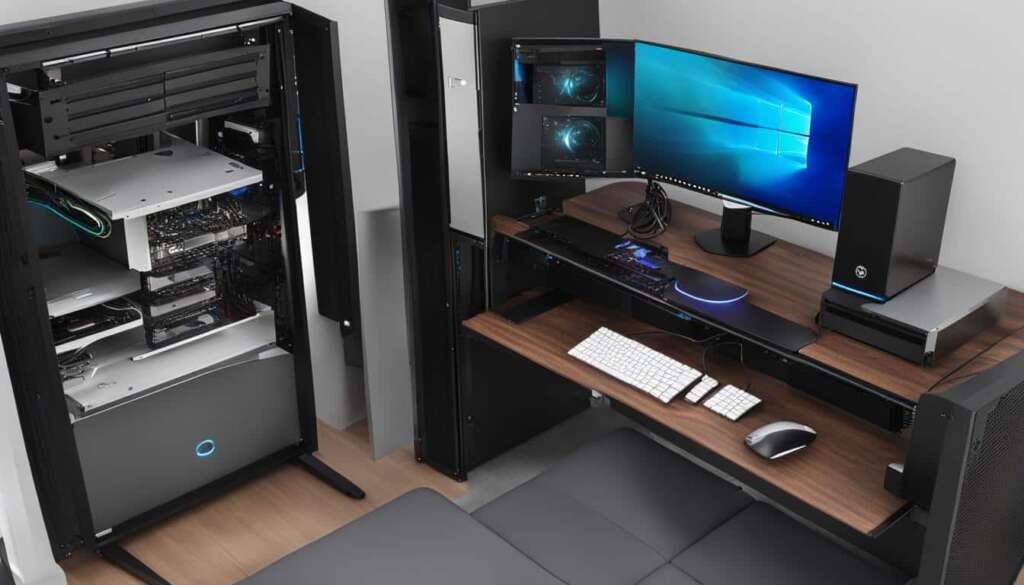Table of Contents
If you have a low-end PC and want to run Starfield smoothly, you can try several optimization methods. By tweaking certain settings and using specific tools, your game’s performance can get a boost. This makes your gameplay much better.
Many gamers struggle with low FPS in Starfield, particularly when combining an Intel CPU with an Nvidia GPU1. AMD FSR 2.0 technology can be a game-changer in Starfield, improving both image quality and performance through upscaling1. Although the game lacks built-in DLSS support for Nvidia cards and XeSS for Intel, mods can enable DLSS 3.0 and XeSS in Starfield1.
Adjusting graphics settings is key to optimizing Starfield on a basic PC. Tests show that setting shadow quality to Ultra can lower performance by 18% for GPU-bound setups2. Lowering volumetric lighting, reflections, and shadow quality from High to Low can boost performance. At the same time, this keeps visuals appealing2. Grass quality’s impact might vary across different areas2.
To improve performance, turn off Fullscreen Optimization for Starfield and make its process a high priority. These adjustments can lead to better frame rates and less stuttering1. Also, installing Starfield on an SSD is essential for smooth gameplay. This matches Bethesda’s minimum suggestions and what players have found13.
Key Takeaways:
- Tweaking graphics settings like shadow quality and reflections can enhance frame rates2.
- Using AMD FSR 2.0 tech in Starfield boosts image quality and performance1.
- Turning off Fullscreen Optimization and prioritizing Starfield’s process can smooth out frame rates1.
- An SSD install for Starfield ensures smoother gameplay13.
- Optimising various visual settings based on your PC setup can offer the best performance2.
Adjusting Graphics Settings for Better Performance
To get better performance in Starfield on your PC, adjust the graphics settings. By doing this, you can enjoy great visuals and smooth play without issues.
Begin by picking the LOW preset in Starfield’s graphics menu for the best performance on simple systems. You might need to tweak more settings to improve the game’s look.
Lowering the render resolution to 75% is a good tip. This balance helps lower-end systems run the game well without losing too much on visuals4.
Those with Nvidia GPUs on simpler systems should try the Starfield DLSS mod by PureDark4. DLSS uses AI to make lower-resolution pictures look better. This makes the game smoother and nicer to look at.
However, even fancy systems with strong GPUs like the RTX 4090 can have troubles. Keeping a good framerate with high settings is tough. It helps to use techniques like DLSS or FSR to boost performance4. Sometimes, waiting for the game to be updated for better performance is the best option.
It’s also smart to turn on VSync if you see screen tearing. But, keep in mind, VSync might make your game respond slower. This could affect how well you play if you prefer things to be more reactive4.
Making the right changes to your graphics in Starfield can really improve how well your game runs. By managing resolution, using DLSS or FSR, and controlling VSync, you find the right mix of looks and functionality. This makes your gaming time more immersive and fun.
Enabling Vertical Sync and Frame Rate Control
To play Starfield smoothly and keep frame rates optimal, it’s key to turn on vertical sync and manage your frame rate. Vertical sync (VSync) makes your graphics card’s output match your monitor’s refresh rate. This stops screen tearing. Turning on VSync improves the look and feel of your game.
Besides, being able to adjust the frame rate lets you set a suitable cap for how many frames show each second. This reduces frame stuttering and smooths out gameplay. It’s particularly helpful for less powerful PCs or when playing graphics-heavy games.
To turn on vertical sync and control frame rates, here’s what to do:
- For NVIDIA graphics card users:
NVIDIA graphics card owners can use the NVIDIA Control Panel to manage these settings. Right-click the desktop and choose “NVIDIA Control Panel” from the menu. Go to “Manage 3D Settings” and select the “Vertical sync” option. Choose “Adaptive (half refresh rate)” for better frame rates. This setting caps frames at 30fps, cuts stuttering, and stabilises gameplay5.
- For AMD graphics card users:
If we compare, data6 shows AMD’s FSR 2 against Nvidia’s DLSS mod.
AMD graphics card users can adjust settings through AMD Radeon Software. Open it and go to the “Gaming” tab. Choose “Global Graphics” and look for “Radeon Anti-Lag.” Using Radeon Anti-Lag reduces input lag and smooths frames for a better play experience6.
But, for the best performance and visuals, Nvidia users often get better results with DLSS mod compared to AMD’s FSR 26. Upgrading hardware or using DLSS mod could lead to smoother gameplay.
Benefits of Enabling Vertical Sync and Frame Rate Control
- Stops screen tearing, making the game look better.
- Cuts down on frame stuttering, leading to smoother gameplay.
- Optimises frame rates and stabilises gameplay.
- Lowers input lag, making controls more responsive.
Considerations for Vertical Sync and Frame Rate Control
- There’s a balance between frame rate and visual quality. Adjust based on your preferences and PC’s capabilities.
- Test how FSR2 or DLSS mod affects visuals and performance to find what works best for you.
- Tweak sharpening settings as per your upscaling method.
- Keep VRS (Variable Rate Shading) on for the best performance.
- Choose film grain intensity and depth of field settings according to what you like.
| Graphics Card | Performance Setting | Average FPS |
|---|---|---|
| RTX 2060 | High | 29 |
| Medium | 37 | |
| Performance | 40 | |
| Low | 45 | |
| RTX 3090 | Ultra | 65 |
| High | 73 | |
| Medium | 82 | |
| Low | 89 |
Display Settings for All Systems
Optimizing display settings in Starfield is key for all players. No matter if your PC is low-end or top-notch, adjusting these settings can make your game run better. They help balance looks and performance.
Dynamic Resolution and Render Resolution Scale
For gamers on less powerful systems, turning on dynamic resolution in Starfield helps. It changes the resolution based on the scene, preventing major FPS drops and making gameplay smoother. Also, setting the render resolution scale to about 75% can boost your frames per second6.
Custom Graphics Presets
Starfield lets players tweak graphics to suit their system. Finding the right setting mix can enhance both visuals and flow. It’s good to try shadows on medium, reflections and GTAO quality on high for smoother play6.
Disabling Performance-Intensive Options
Turning off some graphic settings in Starfield can improve your game’s performance. Lowering shadow quality, volumetric lighting, GTAO, and contact shadows helps a lot6. This makes the game run smoother and respond better.
Motion Blur and Performance Enhancement Technologies
Motion blur can mask performance issues in Starfield. It adds a blur to moving objects, making action seem smoother. This is handy for players on weaker systems seeing occasional lags6.
Nvidia card holders, DLSS can boost your game without hurting visuals. It sharpens low-res images using AI, enhancing frame rates. AMD users can use FSR 2 for similar gains6. This shows how popular and effective DLSS can be, with some making over $40,000 monthly6.
Hardware Configuration and Performance
Starfield’s performance depends a lot on your setup and settings. Testing has shown varied FPS rates across different hardware. For instance, an RTX 2060 and Ryzen 7 3700X setup got 29 to 45 FPS, while an RTX 3090 with the same CPU hit 65 to 89 FPS6.
Yet, even the best settings might not make Starfield perfect on mighty PCs. High-end gear like a Nvidia RTX 4080 FE saw framerates of 80 to 110 FPS outdoors7. Starfield has also proven to rely a lot on CPU power according to tests6.
Optimizing Scene Quality and Framerate
It’s key to balance scene detail and framerate in Starfield’s settings. Higher frames are seen in enclosed areas than open ones. Lighting and shadows can greatly affect how the game looks7.
Resolution Scaling for Performance
Adjusting the FSR 2 scale can help those gaming at high resolutions keep performance up. At 1080p, try not to drop below 85% to stop the visuals from getting blurry7.
Tweaking these settings based on your hardware and what you want from the game can give you a better experience in Starfield. It’s all about finding the perfect balance for the best play on any system.
Optimizing Starfield on Low-End Systems
For players on low-end systems, making Starfield run smoothly can be tough. But, there are many techniques and mods that can help increase performance and FPS.
For NVIDIA GPU users, the Starfield DLSS mod by PureDark is really useful. It improves performance on low-end systems a lot, making the game run smoother4.
If you have an AMD system, try using FSR 2 supersampling. FSR 2 is made to boost frame rates on weaker systems. This can make Starfield perform better4.
Changing the rendering resolution can also make a big difference. Dropping it to about 75% can raise your FPS. However, be aware that reducing it too much might worsen the game’s look4.
Think about turning on dynamic resolution too. It helps stop big drops in FPS on weak systems, keeping the game running smoothly4.
It’s key to adjust specific graphics settings smartly. For example, lower the shadow quality to medium or low for a slight FPS increase without losing much visually. Tweaking particle quality and volumetric lighting to medium or low also helps boost performance without a big impact on the look4.
Optimizing other settings like GTAQ quality, grass quality, crowd density, sharpening, and depth of field is good too. Trying different settings can help you find the perfect balance between how the game runs and looks4.
But remember, not every PC will run Starfield perfectly, despite all adjustments. In some cases, waiting for a game update or using DLSS or FSR on more powerful systems might work better48.
| Optimization Techniques | Performance Impact |
|---|---|
| Installing Starfield DLSS mod (NVIDIA GPUs) | Significant performance boost on low-end systems |
| Utilizing FSR 2 supersampling (AMD systems) | Offset performance issues on low-end systems |
| Adjusting rendering resolution (around 75%) | Improves FPS but may degrade visuals |
| Enabling dynamic resolution | Prevents major FPS drops on low-end systems |
| Tweaking shadow quality, particle quality, and volumetric lighting | Minimal FPS cost, improves performance on low-end GPUs |
Additional Recommendations for Low-End Systems
- Turn off motion blur
- Adjust lighting and shadow options to low settings
- Experiment with other low-end system mods
- Consider upgrading hardware if possible
Following these optimization steps and mods can really help people with low-end systems. They can get Starfield to run smoother. Remember to adjust settings to suit your hardware for the best balance between game performance and visual quality4.
Tips for High-End PC Users
Even high-end PC users might face problems when playing Starfield. However, some tips can help you make your gaming smooth.
- Optimization Techniques for Low-End Systems: Facing slowdowns? Try some tips meant for lesser systems. They can uplift your game’s performance9.
- Utilize DLSS or FSR Supersampling: Enable DLSS (Deep Learning Super Sampling) or FSR (FidelityFX Super Resolution) for a better experience. These techs upscale images using AI, improving performance without losing quality9.
- Adjust Motion Blur, Lighting, and Shadows: Tweaking motion blur, lighting, and shadows can boost performance. Find a good mix between looks and efficiency9.
- Development Patch Consideration: Remember, some issues might need a developer’s patch. Watch out for updates that could fix performance problems in Starfield9.
Follow these suggestions and tune your settings for an enhanced gaming experience in Starfield on a high-end PC.
Recommended PC System Requirements for Starfield
| Operating System | Processor | Memory | Graphics | DirectX | Storage |
|---|---|---|---|---|---|
| Windows 10/11 with updates | AMD Ryzen 5 3600X / Intel i5-10600K | 16 GB RAM | AMD Radeon RX 6800 XT / NVIDIA GeForce RTX 2080 | Version 12 | 125 GB available space (SSD required) |
The table shows the minimum PC needs for Starfield to run well on powerful PCs10.
Meeting or going beyond these specs will give you the best Starfield experience.
Starfield Optimization Conclusion
Analyzing statistics from many places shows a clear plan is needed for smooth Starfield play. Adjusting graphics, enabling vertical sync, and using tools and techniques can boost performance. But even with these changes, low-end systems might still face issues.
Adjusting Graphics Settings
Changing graphics settings is vital for Starfield’s better operation. Data from link 111 shows adjusting graphics can really help FPS on any system. Lowering resolution or turning off some effects can boost game speed without losing good graphics.
Enabling Vertical Sync and Frame Rate Control
Enabling vertical sync and frame rate control makes gameplay smoother, says link 212. Vertical sync matches frame rate with your screen’s rate, cutting screen tearing. Frame rate control stops the GPU from overworking by capping the frame rate.
Utilizing Tools and Techniques
Tools and methods also play a big part, the stats reveal. Techniques like DLSS and FSR improve performance but keep visuals sharp. Though DLSS isn’t on PC now, data from link 111 suggests it might come, offering more tuning options.
Recommended Display Settings
| Resolution | Graphics Settings | Average FPS |
|---|---|---|
| 1440p (Outside Areas) | Dynamic Resolution | ~80fps (Radeon RX 7900 XTX and GeForce RTX 4090)1 |
| 1440p (Inside Environments) | Ultra Settings | 116fps (RTX 4090), 1 |
| 1440p (Outside Planet Areas) | Dynamic Resolution | 38fps (RTX 4060 Ti)1 |
| 4K (Inside Areas) | Dynamic Resolution | 80fps (RTX 4090), 72fps (RX 7900 XTX)1 |
| 4K (Outside Areas) | Dynamic Resolution | 61fps (RTX 4090), 55fps (RX 7900 XTX)1 |
The suggested display settings balance visuals and FPS, using data from link 111. They aim for smooth play and great game visuals.
But, you should tweak these settings for your system and what you like. Optimizing might take trying different settings to find the perfect graphics-FPS balance.
Using these optimization tips can really improve your game time. Stay up-to-date with the game’s latest upgrades and fixes. Continuous improvements from the game makers can push Starfield’s performance further, fixing ongoing issues.
To sum up, making Starfield work best requires tweaking settings, using tools, and keeping up with new fixes. Following these steps and knowing your PC’s limits will make your Starfield adventure even better, letting you dive deep into its vast space world.
Conclusion
Making Starfield work well on less powerful PCs can really make the game more fun. It means the game will run smoothly and look better. You should adjust the settings to fit your computer’s power. Also, turn on vertical sync and control the frame rate for a better gaming experience. Using DLSS or FSR supersampling can also improve how the game performs without losing image quality. Remember, different PCs might need different adjustments, updates, or patches to improve the game.
The minimum needs for Starfield are a CPU like AMD Ryzen 2600X or Intel Core i7-6800K, 16GB of RAM, and certain graphics cards. With these13,you can get about 30 FPS at 1080p resolution, but all settings have to be on low. Yet, many gamers might not have the needed graphics cards13.
For the best game play, using an SSD is advised for quicker loading14. It also helps to have a high-quality power supply. For running Starfield well, update to the latest version of Windows14. If you want a 4K gaming experience, an Intel Core i7-13700K or AMD Ryzen 7900X CPU is better, with 32GB of DDR5 RAM14. The top graphics cards for 4K are NVIDIA RTX 4080 or AMD RX 7900 XTX14.
FAQ
What are some optimization techniques for running Starfield on a low-end PC?
To make Starfield work better on a low-end PC, begin by choosing the LOW preset. Then tweak settings such as indirect lighting and dynamic resolution. Don’t forget shadows and ambient occlusion. Also, consider mods like Starfield DLSS or FSR 2 for better visuals.
Adjust your display settings and rendering resolution. Custom graphics presets can also help.
How can I reduce frame stuttering and ensure a consistent frame rate in Starfield?
Turn on vertical sync with the adaptive half refresh rate setting. You can find this option in the NVIDIA Control Panel for NVIDIA cards. By setting your frame rate cap at 30fps, you’ll see less stuttering. This can also make your game play more smoothly.
What display settings should I consider for Starfield?
Use dynamic resolution to avoid big FPS drops. Aim for a render resolution of about 75% for the right mix of look and performance. Adjusting shadow quality and reflections can also help. Changing GTAO quality is a good idea too.
How can I optimize Starfield on low-end systems?
For NVIDIA GPUs, download the Starfield DLSS mod from PureDark. AMD system users should try FSR 2 supersampling. Changing the rendering resolution can boost performance. Using mods designed for low-end systems might also improve gameplay.
Are there any optimization tips for high-end PC users?
If your high-end PC isn’t running Starfield well, try the tips for low-end PCs. Using DLSS or FSR supersampling is a good idea. Also, adjust your motion blur and shadows. Look out for any new updates or patches from the developers.
Can I expect a completely smooth gameplay experience on a low-end PC?
Optimizing Starfield for low-end PCs can be done, but results may vary depending on your system. You might still encounter some lag, especially on fancy setups. Keep an eye on new updates or patches for improvements.
Are there any additional tips for optimizing Starfield?
Adjusting your graphics settings and turning on vertical sync can help. Using DLSS or FSR supersampling is also a smart move. However, performance will still depend on your PC’s specs. You might need to wait for updates or patches for further improvements.
Is there a conclusion to the Starfield optimization guide?
This guide offers various ways to make Starfield run better, whether on low-end or high-end PCs. By tweaking graphics settings and using enhancements like DLSS or FSR, gameplay can be improved. Remember to stay updated with the latest game patches.
Can I run Starfield smoothly on a low-end PC?
By following the Starfield optimization advice, like adjusting settings and using DLSS or FSR, you can get better performance. However, keep in mind that how well it runs depends on your PC. Some issues might not get fixed without future updates.
Source Links
- https://beebom.com/fix-starfield-low-fps-stuttering-pc-performance-issues/ – Starfield Low FPS: How to Fix Stuttering & PC Performance Issues
- http://gamersnexus.net/game-benchmarks-graphics-guides/starfield-graphics-optimization-guide-benchmarks-settings – Starfield Graphics Optimization Guide & Benchmarks, Settings Comparison, & Performance Mods | GamersNexus
- https://www.rockpapershotgun.com/starfield-pc-performance-best-settings – Starfield PC performance and the best settings to use
- https://www.dexerto.com/starfield/starfield-best-pc-settings-and-optimization-2275519/ – Dexerto
- https://www.escapistmagazine.com/best-graphics-settings-for-starfield/ – Best Graphics Settings for Starfield – The Escapist
- https://www.videogamer.com/guides/starfield-graphics-settings/ – Best Starfield graphics settings PC – high fps and performance
- https://www.pcinvasion.com/best-pc-graphics-settings-for-starfield/ – Best PC graphics settings for Starfield
- https://www.gameleap.com/articles/optimizing-starfield-on-pc-best-settings-for-smooth-gameplay – Optimizing Starfield on PC: Best Settings for Smooth Gameplay
- https://www.techspot.com/guides/2732-starfield-optimization/ – Starfield Optimization Guide
- https://www.charlieintel.com/starfield/starfield-best-pc-graphics-settings-269935/ – Charlie INTEL
- https://www.theverge.com/23855205/starfield-pc-performance-benchmarks-hands-on – How well does Starfield run on PC?
- https://dotesports.com/starfield/news/how-to-fix-starfield-low-performance-issues – How to fix Starfield low performance issues on PC
- https://community.microcenter.com/discussion/13647/starfield-specs-is-your-pc-space-ready – Starfield Specs: Is Your PC Space Ready?
- https://www.chillblast.com/blog/starfield-specs-pc-requirements – Starfield Specs & PC Requirements








